Multi-Step Biomass Fractionation of Grape Seeds from Pomace, a Zero-Waste Approach
Abstract
1. Introduction
2. Results and Discussion
2.1. Chemical Composition
2.2. Multi-Step Biomass Fractionation Grape Seeds
2.2.1. First-Step: Lipid Recovery
2.2.2. Second Step: Polyphenol Extraction from Defatted Grape Seeds
2.2.3. Third Step: Protein Recovery from Defatted and Dephenolized Grape Seeds
2.2.4. Grape Seed Residue
3. Materials and Methods
3.1. Plant Material
3.2. Multi-Step Biomass Fractionation Grape Seeds
3.2.1. First Step: Lipid Extraction
3.2.2. Second Step: Polyphenol Extraction from Defatted Grape Seeds
3.2.3. Third Step: Extraction of Proteins from Defatted and Dephenolized Grape Seeds
3.2.4. Exhausted Grape Seed Residue
3.3. Dry Matter and Ash Content
3.4. Carbohydrate Identification and Quantification
3.5. Fatty Acid Identification and Quantification
3.6. Total Phenolic Content
3.7. Identification and Quantification of Phenolic Compounds
3.8. Protein Identification and Quantification
3.9. Biological Activities of Polyphenol and Protein Extracts
3.9.1. Diphenyl-2-Picrylhydrazyl Free Radical Scavenging Activity (DPPH)
3.9.2. Ferric Reducing Antioxidant Power Assay (FRAP)
3.9.3. CUPRIC Ion Reducing Antioxidant Capacity Assay (CUPRAC)
3.10. Statistical Analyses
4. Conclusions
Author Contributions
Funding
Data Availability Statement
Acknowledgments
Conflicts of Interest
References
- Baroi, A.M.; Popitiu, M.; Fierascu, I.; Sărdărescu, I.-D.; Fierascu, R.C. Grapevine Wastes: A Rich Source of Antioxidants and Other Biologically Active Compounds. Antioxidants 2022, 11, 393. [Google Scholar] [CrossRef]
- Bordiga, M.; Travaglia, F.; Locatelli, M. Valorisation of Grape Pomace: An Approach That Is Increasingly Reaching Its Maturity—A Review. Int. J. Food Sci. Technol. 2019, 54, 933–942. [Google Scholar] [CrossRef]
- Maicas, S.; Mateo, J. Sustainability of Wine Production. Sustainability 2020, 12, 559. [Google Scholar] [CrossRef]
- Arvanitoyannis, I.; Ladas, D.; Mavromatis, A. Wine waste treatment methodology. Int. J. Food Sci. Technol. 2006, 41, 1117–1151. [Google Scholar] [CrossRef]
- Dimić, I.; Teslić, N.; Putnik, P.; Bursać Kovačević, D.; Zeković, Z.; Šojić, B.; Mrkonjić, Ž.; Čolović, D.; Montesano, D.; Pavlić, B. Innovative and Conventional Valorizations of Grape Seeds from Winery By-Products as Sustainable Source of Lipophilic Antioxidants. Antioxidants 2020, 9, 568. [Google Scholar] [CrossRef]
- Fraga, C.G.; Croft, K.D.; Kennedy, D.O.; Tomás-Barberán, F.A. The Effects of Polyphenols and Other Bioactives on Human Health. Food Funct. 2019, 10, 514–528. [Google Scholar] [CrossRef]
- Mantena, S.K.; Katiyar, S.K. Grape Seed Proanthocyanidins Inhibit UV-Radiation-Induced Oxidative Stress and Activation of MAPK and NF-κβ Signaling in Human Epidermal Keratinocytes. Free. Radic. Biol. Med. 2006, 40, 1603–1614. [Google Scholar] [CrossRef] [PubMed]
- Zhou, K.; Raffoul, J. Potential Anticancer Properties of Grape Antioxidants. J. Oncol. 2012, 2012, e803294. [Google Scholar] [CrossRef] [PubMed]
- Ovcharova, T.; Zlatanov, M.; Dimitrova, R. Chemical Composition of Seeds of Four Bulgarian Grape Varieties. Ciênc. Téc. Vitiviníc. 2016, 31, 31–40. [Google Scholar] [CrossRef]
- Yalcin, H.; Kavuncuoglu, H.; Ekici, L.; Sagdic, O. Determination of Fatty Acid Composition, Volatile Components, Physico-Chemical and Bioactive Properties of Grape (Vitis vinifera) Seed and Seed Oil. J. Food Process. Preserv. 2017, 41, e12854. [Google Scholar] [CrossRef]
- Kapcsándi, V.; Lakatos, E.H.; Sik, B.; Linka, L.Á.; Székelyhidi, R. Characterization of Fatty Acid, Antioxidant, and Polyphenol Content of Grape Seed Oil from Different Vitis vinifera L. Varieties. Oilseeds Fats Crops Lipids 2021, 28, 30. [Google Scholar] [CrossRef]
- Surini, S. Gel Formulation Containing Microcapsules of Grape Seed Oil (Vitis vinifera L.) for Skin Moisturizer. J. Young Pharm. 2018, 10, 41–47. [Google Scholar] [CrossRef]
- Zhou, T.; Zhang, T.; Liu, W.; Zhao, G. Physicochemical Characteristics and Functional Properties of Grape (Vitis vinifera L.) Seeds Protein. Int. J. Food Sci. Technol. 2011, 46, 635–641. [Google Scholar] [CrossRef]
- Valiente, C.; Arrigoni, E.; Esteban, R.; Amadò, R. Grape Pomace as a Potential Food Fiber. J. Food Sci. 1995, 60, 818–820. [Google Scholar] [CrossRef]
- Harris, P.J.; Blakeney, A.B.; Henry, R.J.; Stone, B.A. Gas Chromatographic Determination of the Monosaccharide Composition of Plant Cell Wall Preparations. J. Assoc. Off. Anal. Chem. 1988, 71, 272–275. [Google Scholar] [CrossRef]
- Martin, M.E.; Grao-Cruces, E.; Millan-Linares, M.C.; Montserrat-de la Paz, S. Grape (Vitis vinifera L.) Seed Oil: A Functional Food from the Winemaking Industry. Foods 2020, 9, 1360. [Google Scholar] [CrossRef]
- Juhaimi, F.A.; Geçgel, Ã.; Gülcü, M.; Hamurcu, M.; Özcan, M.M. Bioactive Properties, Fatty Acid Composition and Mineral Contents of Grape Seed and Oils. South Afr. J. Enol. Vitic. 2017, 38, 103–108. [Google Scholar] [CrossRef]
- Eikani, M.; Golmohammad, F. Optimized Superheated Hexane Extraction of Grapeseed Oil. J. Food Lipids 2009, 16, 514–523. [Google Scholar] [CrossRef]
- Di Stefano, V.; Bongiorno, D.; Buzzanca, C.; Indelicato, S.; Santini, A.; Lucarini, M.; Fabbrizio, A.; Mauro, M.; Vazzana, M.; Arizza, V.; et al. Fatty Acids and Triacylglycerols Profiles from Sicilian (Cold Pressed vs. Soxhlet) Grape Seed Oils. Sustainability 2021, 13, 13038. [Google Scholar] [CrossRef]
- Karaman, S.; Karasu, S.; Tornuk, F.; Toker, O.S.; Geçgel, Ü.; Sagdic, O.; Ozcan, N.; Gül, O. Recovery Potential of Cold Press Byproducts Obtained from the Edible Oil Industry: Physicochemical, Bioactive, and Antimicrobial Properties. J. Agric. Food Chem. 2015, 63, 2305–2313. [Google Scholar] [CrossRef]
- Kim, D.-J.; Jeon, G.; Sung, J.; Oh, S.-K.; Hong, H.-C.; Lee, J. Effect of Grape Seed Oil Supplementation on Plasma Lipid Profiles in Rats. Food Sci. Biotechnol. 2010, 19, 249–252. [Google Scholar] [CrossRef]
- Górnaś, P.; Rudzińska, M. Seeds Recovered from Industry By-Products of Nine Fruit Species with a High Potential Utility as a Source of Unconventional Oil for Biodiesel and Cosmetic and Pharmaceutical Sectors. Ind. Crops Prod. 2016, 83, 329–338. [Google Scholar] [CrossRef]
- Samavardhana, K.; Supawititpattana, P.; Jittrepotch, N.; Rojsuntornkitti, K.; Kongbangkerd, T. Effects of Extracting Conditions on Phenolic Compounds and Antioxidant Activity from Different Grape Processing Byproducts. Int. Food Res. J. 2015, 22, 1169–1179. [Google Scholar]
- Anastasiadi, M.; Pratsinis, H.; Kletsas, D.; Skaltsounis, A.-L.; Haroutounian, S.A. Bioactive Non-Coloured Polyphenols Content of Grapes, Wines and Vinification by-Products: Evaluation of the Antioxidant Activities of Their Extracts. Food Res. Int. 2010, 43, 805–813. [Google Scholar] [CrossRef]
- Xu, Y.; Burton, S.; Kim, C.; Sismour, E. Phenolic Compounds, Antioxidant, and Antibacterial Properties of Pomace Extracts from Four Virginia-Grown Grape Varieties. Food Sci. Nutr. 2016, 4, 125–133. [Google Scholar] [CrossRef]
- Özcan, M.M.; Al Juhaimi, F.; Gülcü, M.; Uslu, N.; Geçgel, Ü. Determination of Bioactive Compounds and Mineral Contents of Seedless Parts and Seeds of Grapes. South Afr. J. Enol. Vitic. 2017, 38, 212–220. [Google Scholar] [CrossRef]
- Rockenbach, I.I.; Gonzaga, L.V.; Rizelio, V.M.; Gonçalves, A.E.d.S.S.; Genovese, M.I.; Fett, R. Phenolic Compounds and Antioxidant Activity of Seed and Skin Extracts of Red Grape (Vitis vinifera and Vitis labrusca) Pomace from Brazilian Winemaking. Food Res. Int. 2011, 44, 897–901. [Google Scholar] [CrossRef]
- Frutos, M.J.; Rincón-Frutos, L.; Valero-Cases, E. Chapter 2.14—Rutin. In Nonvitamin and Nonmineral Nutritional Supplements; Nabavi, S.M., Silva, A.S., Eds.; Academic Press: Cambridge, MA, USA, 2019; pp. 111–117. [Google Scholar] [CrossRef]
- Chen, C. Sinapic Acid and Its Derivatives as Medicine in Oxidative Stress-Induced Diseases and Aging. Oxidative Med. Cell. Longev. 2016, 2016, 3571614. [Google Scholar] [CrossRef]
- Salem, Y.; Rajha, H.N.; Franjieh, D.; Hoss, I.; Manca, M.L.; Manconi, M.; Castangia, I.; Perra, M.; Maroun, R.G.; Louka, N. Stability and Antioxidant Activity of Hydro-Glyceric Extracts Obtained from Different Grape Seed Varieties Incorporated in Cosmetic Creams. Antioxidants 2022, 11, 1348. [Google Scholar] [CrossRef] [PubMed]
- Di Stefano, V.; Buzzanca, C.; Melilli, M.G.; Indelicato, S.; Mauro, M.; Vazzana, M.; Arizza, V.; Lucarini, M.; Durazzo, A.; Bongiorno, D. Polyphenol Characterization and Antioxidant Activity of Grape Seeds and Skins from Sicily: A Preliminary Study. Sustainability 2022, 14, 6702. [Google Scholar] [CrossRef]
- Zduńska, K.; Dana, A.; Kolodziejczak, A.; Rotsztejn, H. Antioxidant Properties of Ferulic Acid and Its Possible Application. Ski. Pharmacol. Physiol. 2018, 31, 332–336. [Google Scholar] [CrossRef]
- Espíndola, K.M.M.; Ferreira, R.G.; Narvaez, L.E.M.; Silva Rosario, A.C.R.; da Silva, A.H.M.; Silva, A.G.B.; Vieira, A.P.O.; Monteiro, M.C. Chemical and Pharmacological Aspects of Caffeic Acid and Its Activity in Hepatocarcinoma. Front. Oncol. 2019, 9, 541. [Google Scholar] [CrossRef] [PubMed]
- Iuga, M.; Ropciuc, S.; Mironeasa, S. Antioxidant activity and total phenolic content of grape seeds and peels from Romanian varieties. Food Environ. Saf. J. 2017, 16. [Google Scholar]
- Rajha, H.N.; Darra, N.E.; Hobaika, Z.; Boussetta, N.; Vorobiev, E.; Maroun, R.G.; Louka, N. Extraction of Total Phenolic Compounds, Flavonoids, Anthocyanins and Tannins from Grape Byproducts by Response Surface Methodology. Influence of Solid-Liquid Ratio, Particle Size, Time, Temperature and Solvent Mixtures on the Optimization Process. Food Nutr. Sci. 2014, 5, 397–409. [Google Scholar] [CrossRef]
- Rajha, H.N.; Louka, N.; Darra, N.E.; Hobaika, Z.; Boussetta, N.; Vorobiev, E.; Maroun, R.G. Multiple Response Optimization of High Temperature, Low Time Aqueous Extraction Process of Phenolic Compounds from Grape Byproducts. Food Nutr. Sci. 2014, 5, 351–360. [Google Scholar] [CrossRef]
- Baca-Bocanegra, B.; Nogales-Bueno, J.; Hernández-Hierro, J.M.; Heredia, F.J. Optimization of Protein Extraction of Oenological Interest from Grape Seed Meal Using Design of Experiments and Response Surface Methodology. Foods 2021, 10, 79. [Google Scholar] [CrossRef]
- Lee, H.; Kim, J.; Ji, D.; Lee, C. Effects of Heating Time and Temperature on Functional Properties of Proteins of Yellow Mealworm Larvae (Tenebrio molitor L.). Food Sci. Anim. Resour. 2019, 39, 296–308. [Google Scholar] [CrossRef]
- Gianazza, E.; Celentano, F.; Magenes, S.; Ettori, C.; Righetti, P.G. Formulations for immobilized pH gradients including pH extremes. Electrophoresis 1989, 10, 806–808. [Google Scholar] [CrossRef]
- Chamizo-González, F.; Heredia, F.J.; Rodríguez-Pulido, F.J.; González-Miret, M.L.; Gordillo, B. Proteomic and Computational Characterisation of 11S Globulins from Grape Seed Flour By-Product and Its Interaction with Malvidin 3-Glucoside by Molecular Docking. Food Chem. 2022, 386, 132842. [Google Scholar] [CrossRef]
- Tandang-Silvas, M.R.G.; Tecson-Mendoza, E.M.; Mikami, B.; Utsumi, S.; Maruyama, N. Molecular Design of Seed Storage Proteins for Enhanced Food Physicochemical Properties. Annu. Rev. Food Sci. Technol. 2011, 2, 59–73. [Google Scholar] [CrossRef]
- Zhou, T.; Li, Q.; Zhang, J.; Bai, Y.; Zhao, G. Purification and Characterization of a New 11S Globulin-like Protein from Grape (Vitis vinifera L.) Seeds. Eur. Food Res. Technol. 2010, 230, 693–699. [Google Scholar] [CrossRef]
- Da Porto, C.; Porretto, E.; Decorti, D. Comparison of Ultrasound-Assisted Extraction with Conventional Extraction Methods of Oil and Polyphenols from Grape (Vitis vinifera L.) Seeds. Ultrason. Sonochem. 2013, 20, 1076–1080. [Google Scholar] [CrossRef] [PubMed]
- Maroun, R.G.; Rajha, H.N.; Vorobiev, E.; Louka, N. 7—Emerging Technologies for the Recovery of Valuable Compounds from Grape Processing By-Products. In Handbook of Grape Processing By-Products; Galanakis, C.M., Ed.; Academic Press: Cambridge, MA, USA, 2017; pp. 155–181. [Google Scholar] [CrossRef]
- Gilbert-López, B.; Mendiola, J.A.; Fontecha, J.; van den Broek, L.A.M.; Sijtsma, L.; Cifuentes, A.; Herrero, M.; Ibáñez, E. Downstream Processing of Isochrysis galbana: A Step towards Microalgal Biorefinery. Green Chem. 2015, 17, 4599–4609. [Google Scholar] [CrossRef]
- De Keijzer, J.; van den Broek, L.A.M.; Ketelaar, T.; van Lammeren, A.A.M. Histological Examination of Horse Chestnut Infection by Pseudomonas syringae Pv. Aesculi and Non-Destructive Heat Treatment to Stop Disease Progression. PLoS ONE 2012, 7, e39604. [Google Scholar] [CrossRef]
- Singleton, V.L.; Orthofer, R.; Lamuela-Raventós, R.M. Reagent. In Methods in Enzymology; Oxidants and Antioxidants Part A; Academic Press: Cambridge, MA, USA, 1999; Volume 299, pp. 152–178. [Google Scholar] [CrossRef]
- Rajha, H.N.; Boussetta, N.; Louka, N.; Maroun, R.G.; Vorobiev, E.A. Comparative Study of Physical Pretreatments for the Extraction of Polyphenols and Proteins from Vine Shoots. Food Res. Int. 2014, 65, 462–468. [Google Scholar] [CrossRef]
- Mariotti, F.; Tomé, D.; Mirand, P.P. Converting Nitrogen into Protein--beyond 6.25 and Jones’ Factors. Crit. Rev. Food Sci. Nutr. 2008, 48, 177–184. [Google Scholar] [CrossRef] [PubMed]
- Gyamfi, M.A.; Yonamine, M.; Aniya, Y. Free-Radical Scavenging Action of Medicinal Herbs from Ghana: Thonningia Sanguinea on Experimentally Induced Liver Injuries. Gen. Pharmacol. Vasc. Syst. 1999, 32, 661–667. [Google Scholar] [CrossRef]
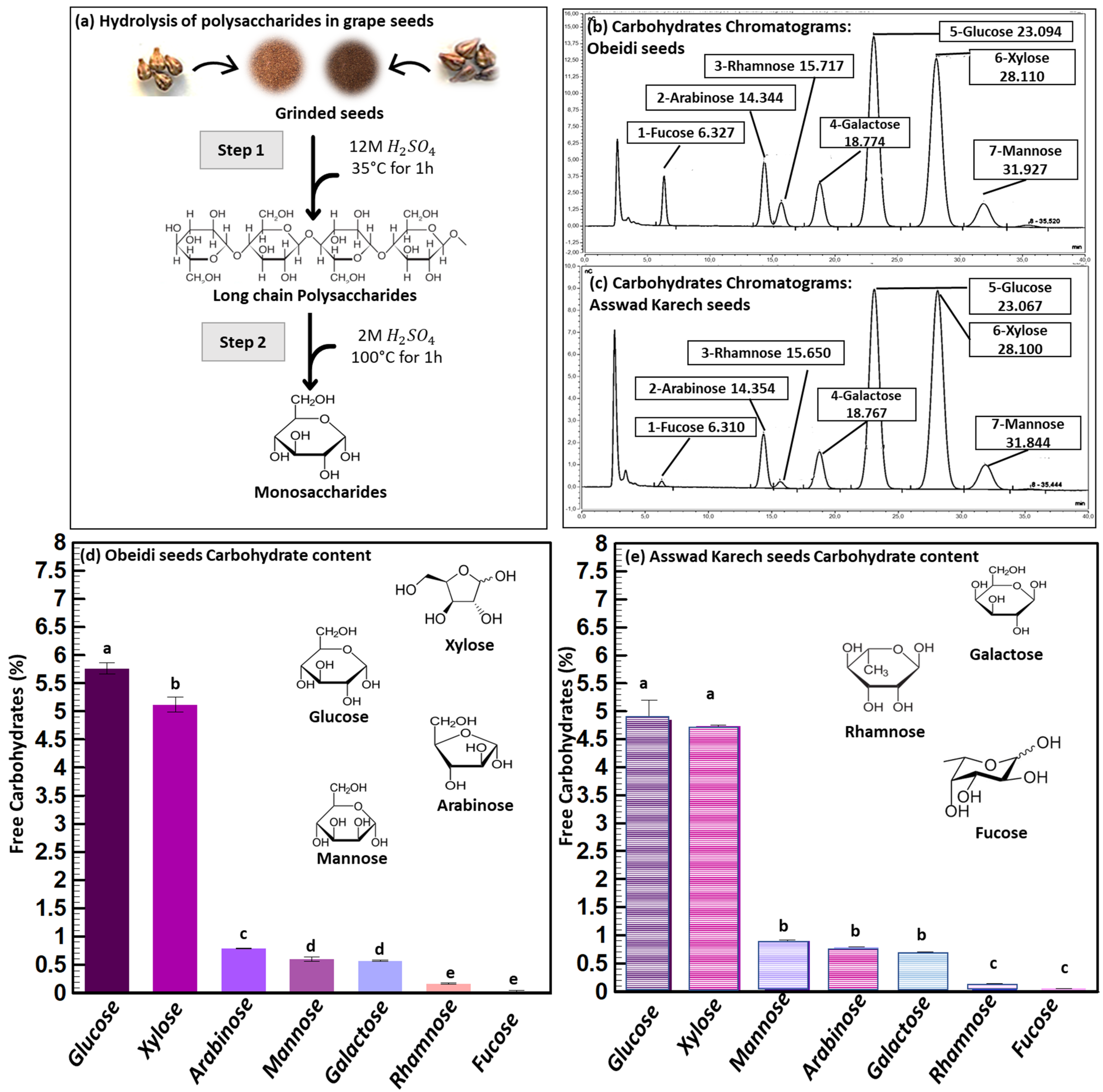
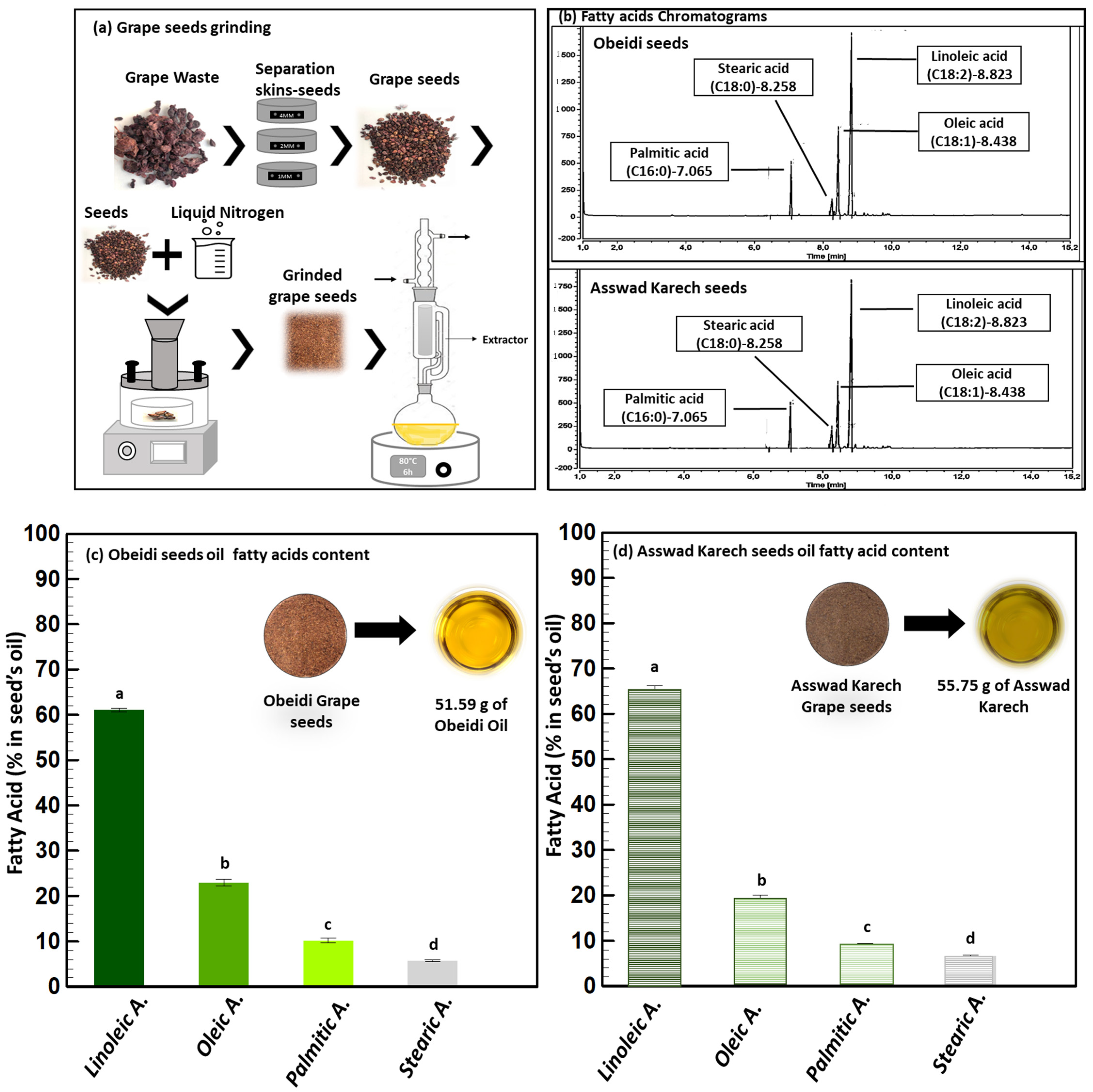
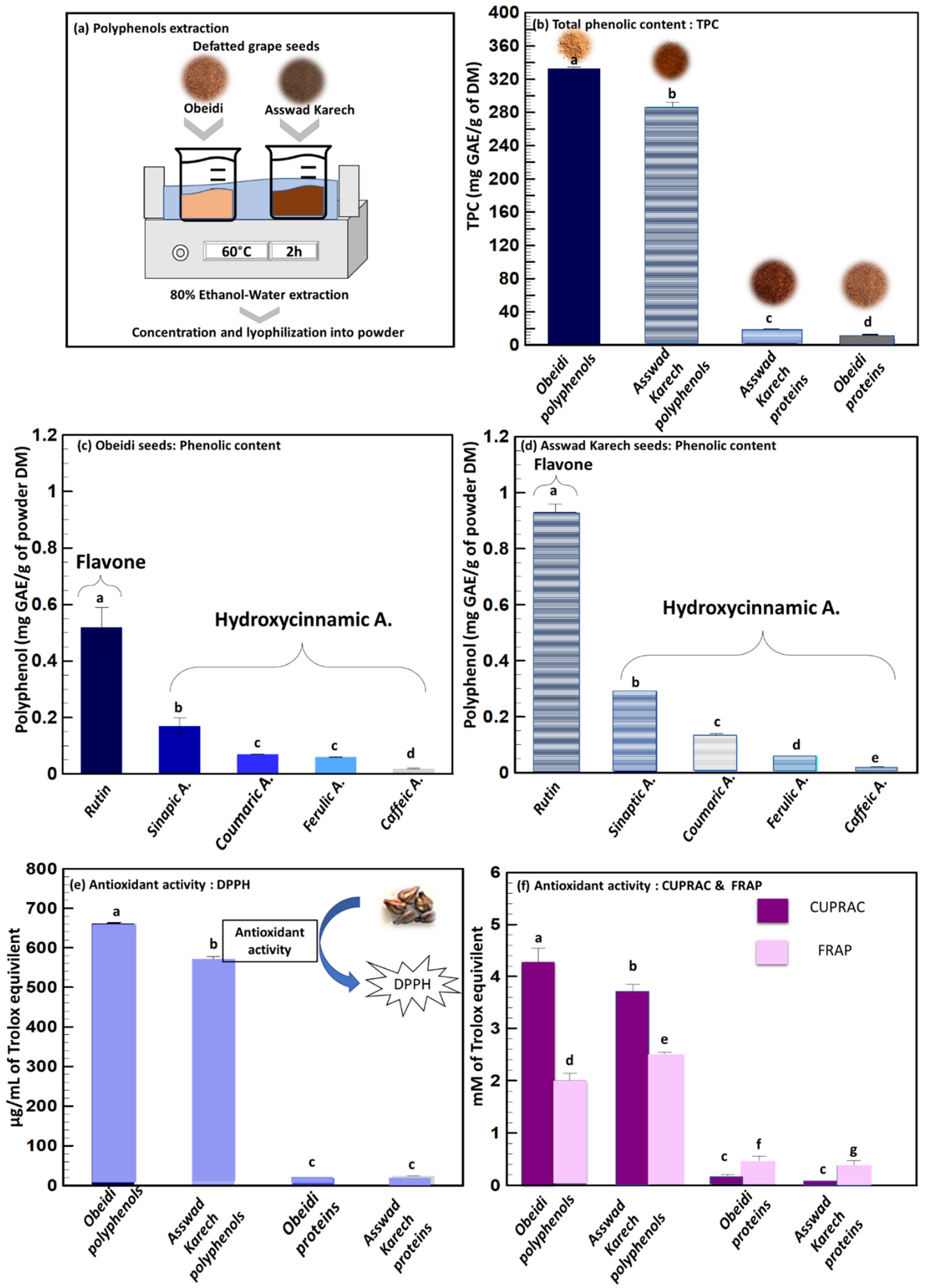
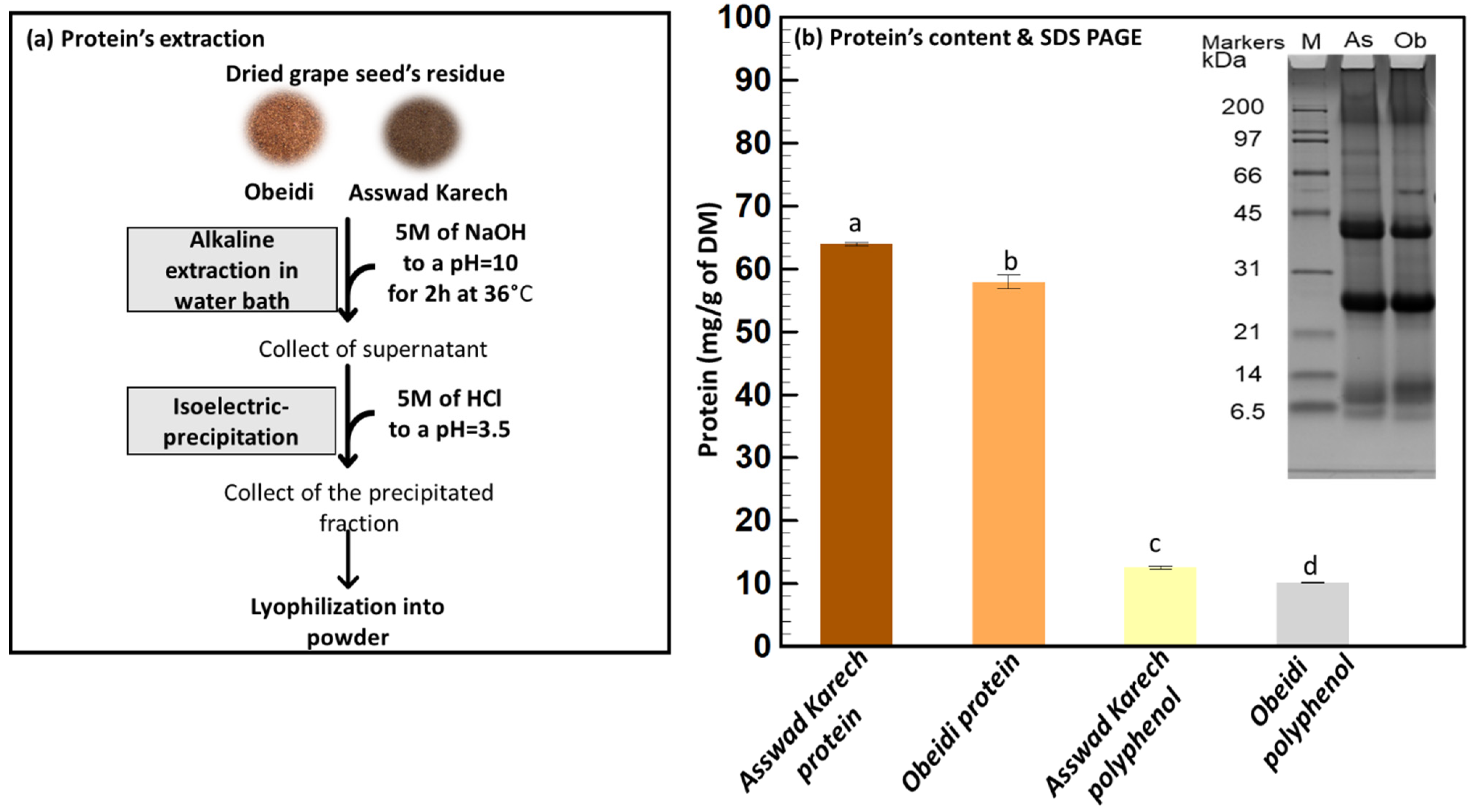
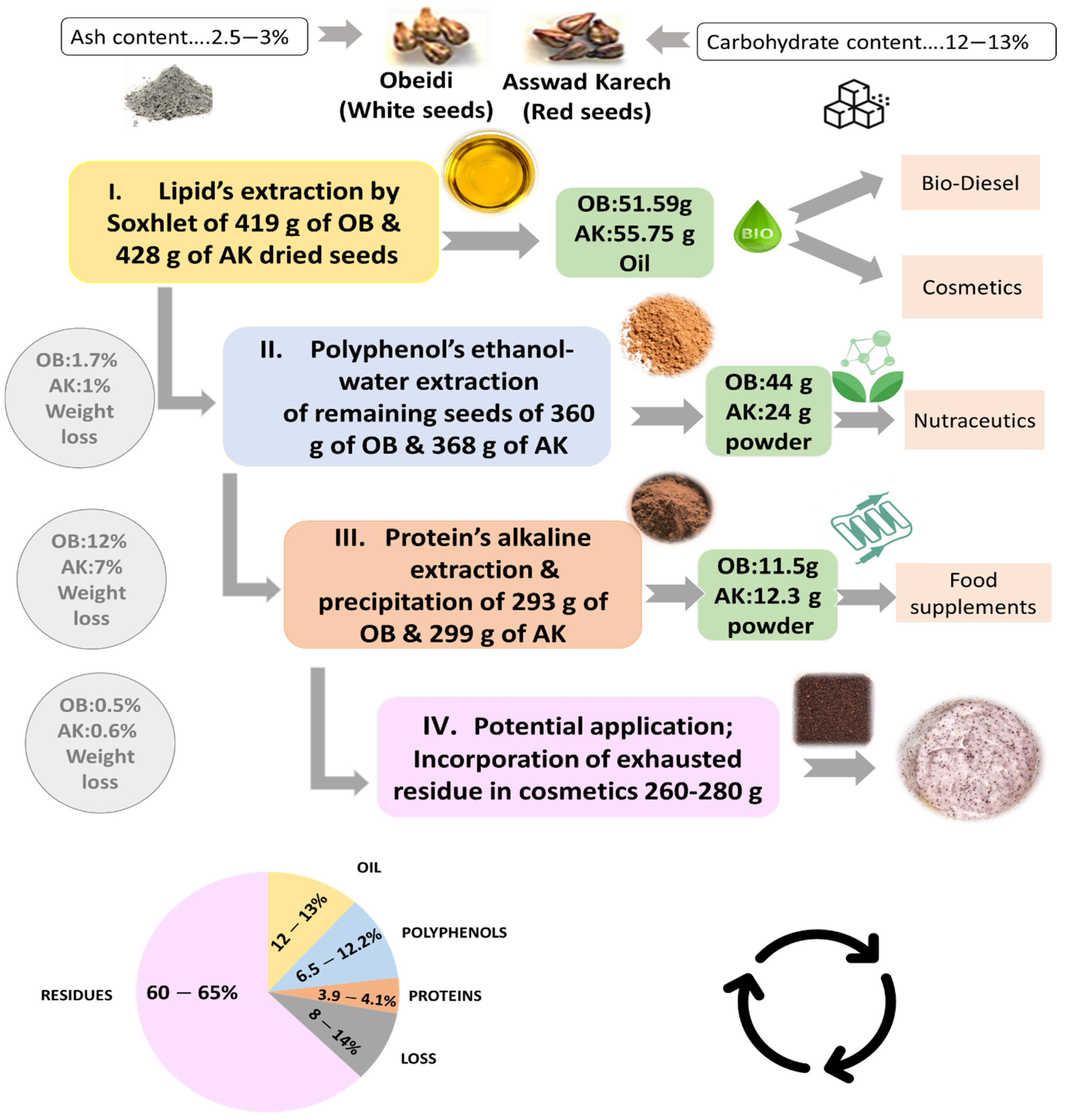
| Obeidi | Asswad Karech | |
|---|---|---|
| Dry matter content | 88.57 ± 0.45 | 88.32 ± 0.46 |
| Ash content (525 °C) | 3.00 ± 0.11 | 2.96 ± 0.06 |
| Ash content (900 °C) | 2.29 ± 0.11 | 2.65 ± 0.49 |
| Polyphenol Fraction | Protein Fraction | |||
|---|---|---|---|---|
| Obeidi | Asswad Karech | Obeidi | Asswad Karech | |
| Weigh of fraction (g) | 44.0 ± 1.0 | 24.0 ± 1.0 | 11.5 ± 1.0 | 12.3 ± 1.0 |
| Total phenolic content (mg/g extract DM) | 333.1 ± 1.66 | 287.15 ± 5.18 | 4.43± 0.01 | 7.43 ± 1.02 |
| Polyphenol purity (Equation (2)) | 97.0% | 95.8% | 7.0% | 10.4% |
| Protein content (mg/g extract DM) | 10.14± 0.11 | 12.56 ± 0.22 | 57.93 ± 1.11 | 63.95 ± 0.24 |
| Protein purity (Equation (4)) | 3.0% | 4.2% | 93.0% | 89.6% |
Publisher’s Note: MDPI stays neutral with regard to jurisdictional claims in published maps and institutional affiliations. |
© 2022 by the authors. Licensee MDPI, Basel, Switzerland. This article is an open access article distributed under the terms and conditions of the Creative Commons Attribution (CC BY) license (https://creativecommons.org/licenses/by/4.0/).
Share and Cite
Salem, Y.; Rajha, H.N.; van den Broek, L.A.M.; Safi, C.; Togtema, A.; Manconi, M.; Manca, M.L.; Debs, E.; Hobaika, Z.; Maroun, R.G.; et al. Multi-Step Biomass Fractionation of Grape Seeds from Pomace, a Zero-Waste Approach. Plants 2022, 11, 2831. https://doi.org/10.3390/plants11212831
Salem Y, Rajha HN, van den Broek LAM, Safi C, Togtema A, Manconi M, Manca ML, Debs E, Hobaika Z, Maroun RG, et al. Multi-Step Biomass Fractionation of Grape Seeds from Pomace, a Zero-Waste Approach. Plants. 2022; 11(21):2831. https://doi.org/10.3390/plants11212831
Chicago/Turabian StyleSalem, Yara, Hiba N. Rajha, Lambertus A. M. van den Broek, Carl Safi, Arnoud Togtema, Maria Manconi, Maria Letizia Manca, Espérance Debs, Zeina Hobaika, Richard G. Maroun, and et al. 2022. "Multi-Step Biomass Fractionation of Grape Seeds from Pomace, a Zero-Waste Approach" Plants 11, no. 21: 2831. https://doi.org/10.3390/plants11212831
APA StyleSalem, Y., Rajha, H. N., van den Broek, L. A. M., Safi, C., Togtema, A., Manconi, M., Manca, M. L., Debs, E., Hobaika, Z., Maroun, R. G., & Louka, N. (2022). Multi-Step Biomass Fractionation of Grape Seeds from Pomace, a Zero-Waste Approach. Plants, 11(21), 2831. https://doi.org/10.3390/plants11212831














